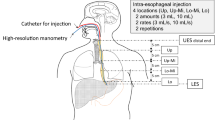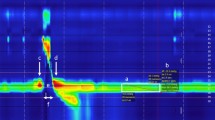Abstract
We tested a manometric assembly employing a sleeve sensor that is able to monitor anterior or posterior pressure in the human upper esophageal sphincter (UES) for prolonged intervals. When compared to rapid pull-through measurement of UES pressure obtained with conventional manometric assemblies, the sleeve sensor measured significantly lower UES pressures with less variability between subjects, thereby suggesting that the rapid pull-through maneuver stimulates the UES to contract. Concurrent recordings of UES pressure with a sleeve sensor and a side-hole sensor during a slow station pull-through yielded almost equal pressure values at the peak of the high-pressure zone (station zero), but the side-hole site recorded significantly lower pressures than the sleeve at stations 0.5 cm or more from the peak of the high-pressure zone. During 10 min of recording at station zero, the sleeve sensor recorded greater pressures than the side-hole sensor. This finding demonstrated the suceptibility of the side-hole sensor to axial movement relative to peak UES pressure. When stationary, both the sleeve sensor and the side-hole sensor recorded significantly lower UES pressure after 1–2 min of recording, again suggesting that movement of the recording assembly stimulates the UES to contract. Sleeve recordings of swallow-induced UES relaxations showed that UES relaxations induced by water swallows were slightly longer than those induced by dry swallows. Augmentations of UES pressure induced by balloon distension of the esophageal body were also recorded. We conclude that the sleeve sensor is a suitable method for investigating the normal physiology and pathophysiology of the UES in human subjects.
Similar content being viewed by others
References
Asoh R, Goyal RJ: Manometry and electromyography of the upper esophageal sphincter in the opossum. Gastroenterology 74:514–520, 1978
Welch RW, Luckman K, Ricks PM, Drake ST, Gates GA: Manometry of the normal upper esophageal sphincter and its alterations in laryngectomy. J Clin Invest 63:1036–1041, 1979
Winans CS: The pharyngoesophageal closure mechanism: A manometric study. Gastroenterology 63:768–777, 1972
Linehan JH, Dent J, Dodds WJ, Hogan WJ: Sleeve device functions as a starling resistor to record sphincter pressure. Am J Physiol 248:G251-G255, 1985
Dent J: A new technique for continuous sphincter pressure measurement. Gastroenterology 71:263–267, 1976
Arndorfer RC, Stef JJ, Dodds WJ, Linehan JH, Hogan WJ: Improved infusion system for intraluminal esophageal manometry. Gastroenterology 73:23–27, 1977
Gerhardt DC, Shuck TM, Bordeaux RA, Winship DH: Human upper esophageal sphincter, response to volume, osmotic and acid stimuli. Gastroenterology 75:268–274, 1978
Isberg A, Nilsson ME, Schiratzki H: Movement of the upper esophageal sphincter and a manometric device during deglutition. Acta Radiol Diag 26(4):381–388, 1985
Sokol EM, Heitmann P, Wolf BS, Cohen BR: Simultaneous cineradiographic and manometric study of the pharynx, hypopharynx and cervical esophagus. Gastroenterology 51:960–974, 1966
Knuff TE, Benjamin SB, Castell DO: Pharyngoesophageal (Zenker's) diverticulum: A reappraisal. Gastroenterology 82:734–736, 1982
Enzmann DR, Harell GS, Zboralske FF: Upper esophageal responses to intraluminal distension in man. Gastroenterology 72:1292–1298, 1977
Freiman JM, El-Sharkawy TY, Diamant NE: Effect of bilateral vagosympathetic nerve blockade on response of the dog upper esophageal sphincter (UES) to intraesophageal distention and acid. Gastroenterology 81:78–84, 1981
Allen CJ, Newhouse MT: Gastroesophageal reflux and chronic respiratory disease. Am Rev Respir Dis 129:645–647, 1984
Author information
Authors and Affiliations
Additional information
Supported by grants (AM 25731 & AM 07572-01) from the National Institutes of Health.
Rights and permissions
About this article
Cite this article
Kahrilas, P.J., Dent, J., Dodds, W.J. et al. A method for continuous monitoring of upper esophageal sphincter pressure. Digest Dis Sci 32, 121–128 (1987). https://doi.org/10.1007/BF01297099
Received:
Revised:
Accepted:
Issue Date:
DOI: https://doi.org/10.1007/BF01297099




